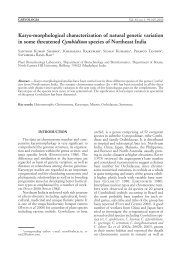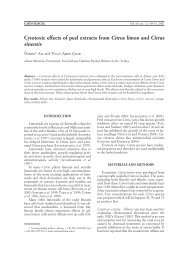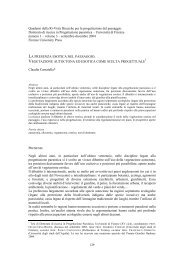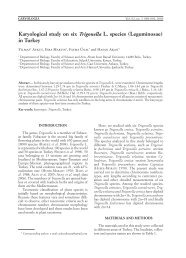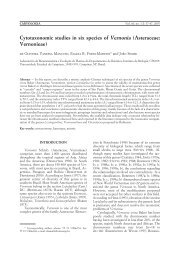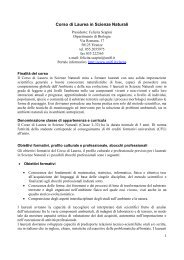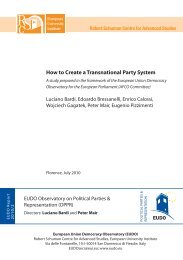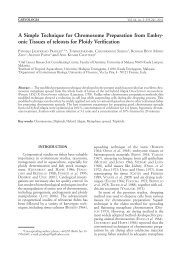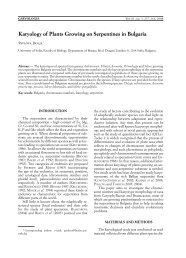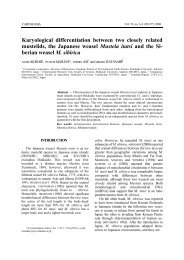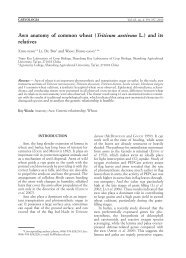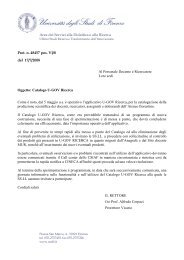A revised cytotaxonomy of the genus Tulbaghia (Alliaceae)
A revised cytotaxonomy of the genus Tulbaghia (Alliaceae)
A revised cytotaxonomy of the genus Tulbaghia (Alliaceae)
You also want an ePaper? Increase the reach of your titles
YUMPU automatically turns print PDFs into web optimized ePapers that Google loves.
106 VOSA<br />
Constitutive heterochromatin in<br />
<strong>Tulbaghia</strong><br />
Constitutive heterochromatin can be defined<br />
as somewhat dispensable, non-transcrib ing,<br />
usually highly repetitive DNA sequences,<br />
preserved by selection and located on <strong>the</strong> chromosomes<br />
as inheritable, inconvertible seg ments.<br />
It differs from facultative heterochromatin which<br />
is thought to be <strong>the</strong> consequence <strong>of</strong> a cytological<br />
situation in which a certain amount <strong>of</strong> normally<br />
coding DNA is temporarily and reversibly<br />
repressed by a special molecular mechanism. An<br />
example <strong>of</strong> facultative heterochromatin are <strong>the</strong><br />
X-chromosomes in female mammals, one <strong>of</strong><br />
which becomes inactive and heterochromatic<br />
and appears, as it were constitutive<br />
heterochromatin, as a chromocentre in <strong>the</strong><br />
interphase nuclei (i.e. <strong>the</strong> Barr-body <strong>of</strong> female<br />
humans).<br />
Constitutive heterochromatic segments (Hsegments)<br />
are present in several species <strong>of</strong> <strong>Tulbaghia</strong><br />
(Table 2 and see VOSA, 1970, 1975). The Hsegments<br />
number, size and position on <strong>the</strong><br />
chromosomes is variable between and, to a certain<br />
extent, also within species. Such segments<br />
are sensitive to cold treatment and present reduced<br />
fluorescence when stained with certain<br />
fluorochromes, in <strong>the</strong> same way as those found<br />
in Paris, Trillium and Cestrum (DARLINGTON<br />
and LA COUR 1938; DYER 1963; VOSA 1966, 1970,<br />
1973; FILION and VOSA 1980). Experiments have<br />
shown that, in <strong>Tulbaghia</strong>, <strong>the</strong>y consist mainly <strong>of</strong><br />
highly repetitive sequences <strong>of</strong> DNA composed,<br />
for <strong>the</strong> most part, <strong>of</strong> Guanine-Cytidine nucleotides<br />
(PACHMAN and RIEGLER 1972; WEISBLUM and de<br />
HASETH 1972).<br />
In some species <strong>of</strong> <strong>Tulbaghia</strong>, such as T. cernua<br />
and T. ludwigiana, <strong>the</strong> total amount <strong>of</strong> heterochromatin,<br />
as a proportion <strong>of</strong> <strong>the</strong> length <strong>of</strong><br />
<strong>the</strong> chromosome complement, has been found in<br />
a few plants to be as much as 25 %.<br />
In respect to <strong>the</strong> presence and to <strong>the</strong> localization<br />
<strong>of</strong> <strong>the</strong> H-segments, <strong>the</strong> species <strong>of</strong> <strong>Tulbaghia</strong><br />
may be subdivided into three groups.<br />
The first group, which includes 10 species, <strong>the</strong><br />
segments are generally very small and almost<br />
exclusively localized ei<strong>the</strong>r side <strong>of</strong> <strong>the</strong> nucleolar<br />
organizers. The second group includes 6 spe cies<br />
where <strong>the</strong> H-segments are relatively large and<br />
are located almost always in distal position (fig.<br />
23). This situation is found also in most <strong>of</strong> <strong>the</strong><br />
American species <strong>of</strong> Trillium (DARLINGTON and<br />
SHAW 1959). In <strong>the</strong> third group, which includes 5<br />
species, <strong>the</strong> H-segments are found mostly in<br />
intercalary position (fig. 24) as in Fritillaria,<br />
Trillium kamschaticum, Trillium erectum and<br />
Cestrum (DYER 1963). The variation in <strong>the</strong><br />
presence, absence and size <strong>of</strong> <strong>the</strong> H-seg ments in<br />
<strong>Tulbaghia</strong>, follows a very similar pattern in<br />
different species within each group, with<br />
Fig. 23 — Mitotic metaphase in <strong>Tulbaghia</strong> cernua, after 36 h at 3-4 °C, stained in Feulgen (x 1500). Note <strong>the</strong> lightly stained distally<br />
located H-segments. The small segments, intercalary between <strong>the</strong> centromere and <strong>the</strong> N.O.'s, are also heterochromatic and lightly<br />
stained (arrowed).




